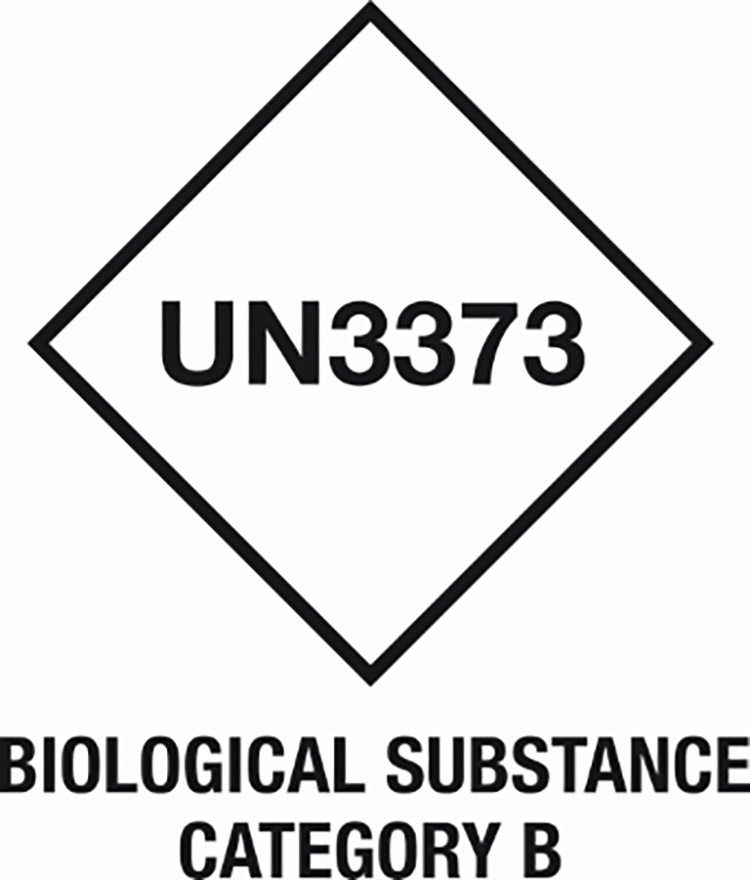|
不符合列入A类标准的传染性物质。应将B类传染性物质分配给UN3373
分配给UN 3373的诊断标本是仅出于诊断或调查目的运输的人或动物材料。这些材料包括排泄物,血液及其成分,以及其他组织和体液。诊断标本不包括活感染的动物。
包装要求在包装说明P650中。
如果已知来源(患者)患有容易传染的严重疾病,并且通常无法采用有效的治疗和预防措施,则必须将该物质分配为UN 2814或UN 2900,视情况而定。
豁免:
-不含传染性物质或不太可能引起传染性的物质
除非人类或动物疾病符合纳入另一类的标准,否则它们不受本规章的约束。
-含有对人类或动物无致病性的微生物的物质,
除非它们符合列入另一类的标准,否则不受本规章的约束。
-某种形式的已存在的病原体已被中和或灭活,
从而不再构成健康风险的物质,除非它们符合列入另一类的标准,否则不受本规章的约束。
注意:已排出自由液体并符合本
款要求的医疗设备不受本规章的约束。
-
除非被认为具有重大感染风险的环境样品(包括食物和水样品)符合纳入另一类的标准,否则不受本规章的约束。
-通过在吸收性材料上滴一滴血或进行粪便隐性
血液筛查试验以及为输血或制备用于输血或移植的血液制品而收集的血液或血液成分收集的干血斑并且打算用于移植的任何组织或器官均不受本规章的约束。
-如果人类或动物标本在包装中运输时应防止病菌的泄漏,并且标有“人类标本免检”或“动物免检”字样,则极少可能存在病原体的人类或动物标本不受本法规的约束标本”。
包装应符合以下条件:
(a)包装应包括三个组成部分:
(i)防漏主容器;
(ii)防漏二级包装;和
(ⅲ)的其容量,重量足够的强度和使用目的的外包装,并用100毫米×100mm的至少一种具有表面的最小尺寸;
(b)对于液体,应将足以吸收全部内容物的吸收性材料放置在主要容器和次要包装之间,以便在运输过程中液体物质的任何释放或泄漏都不会到达外包装并且不会损害缓冲材料的完整性;
(c)将多个易碎的主容器放在单个辅助包装中时,应单独包装或分开包装,以防止它们之间接触。
注意1:需要一种专业判断力来确定一种物质是否根据本款得到豁免。该判断应基于已知的病史,病原体,人或动物的症状和个人情况,以及当地的地方情况。可以根据本款运输的标本包括血液或尿液检查以监测胆固醇,血糖,激素或前列腺特异性抗体(PSA);监测器官或功能(如非传染性疾病的人类或动物的心,肝或肾功能)或监测药物的功能;为保险或雇用目的而进行的旨在确定是否存在毒品或酒精的行为;怀孕测试; 活检以检测癌症;
注2:对于航空运输,本款规定豁免的标本包装应符合(a)至(c)的条件。
除了:
(a)医疗废物(UN 3291);
(b)被A类传染性物质污染或包含的医疗器械或设备(UN 2814或UN 2900);和
(c)被污染或包含符合其他危险类别定义的其他危险物品的医疗设备或设备,可能被污染或包含传染性物质的医疗设备或设备正在运输以进行消毒,清洁,灭菌,维修或评估设备。如果以在正常运输条件下不会破裂,刺破或泄漏其内装物的方式设计和制造的包装中包装,则不受本规章的约束。包装的设计应符合建造要求。
这些包装应符合一般包装要求,并在从1.2 m的高度跌落时能够保留医疗设备。对于航空运输,可能需要遵守其他要求。
包装上应标明“二手医疗设备”或“二手医疗设备”。当使用外包装时,这些标签应以相同的方式标记,除非铭文仍然可见。
An infectious substance which does not meet the criteria for inclusion in Category A. Infectious substances in Category B shall be assigned to UN3373
Diagnostic specimens, assigned to UN 3373, are human or animal materials that are being transported only for the purpose of diagnosis or investigation. Such materials include excreta, blood and itscomponents, as well as other tissues and fluids. Diagnostic specimens do not include live infected animals.
Packaging requirements are at packing instruction P 650.
If the source (the patient) is known to have a serious disease that can be readily transmitted and for which effective treatment and preventative measures are not usually available, then the substance must beassigned UN 2814 or UN 2900, as appropriate.
Exemptions:
- Substances which do not contain infectious substances or substances which are unlikely to cause
disease in humans or animals are not subject to these Regulations unless they meet the criteria for inclusion in another class.
- Substances containing microorganisms which are non-pathogenic to humans or animals are not
subject to these Regulations unless they meet the criteria for inclusion in another class.
- Substances in a form that any present pathogens have been neutralized or inactivated such that
they no longer pose a health risk are not subject to these Regulations unless they meet the criteria for inclusion in another class.
NOTE: Medical equipment which has been drained of free liquid and meets the requirements of this
paragraph is not subject to these Regulations.
- Environmental samples (including food and water samples) which are not considered to pose a
significant risk of infection are not subject to these Regulations unless they meet the criteria for inclusion in another class.
- Dried blood spots, collected by applying a drop of blood onto absorbent material, or faecal occult
blood screening tests and blood or blood components which have been collected for the purposes of transfusion or for the preparation of blood products to be used for transfusion or transplantation and any tissues or organs intended for use in transplantation are not subject to these Regulations.
-Human or animal specimens for which there is minimal likelihood that pathogens are present are not subject to these Regulations if the specimen is transported in a packaging which will prevent any leakage and which is marked with the words “Exempt human specimen” or “Exempt animal specimen”, as appropriate.
The packaging should meet the following conditions:
(a) The packaging should consist of three components:
(i) a leak-proof primary receptacle(s);
(ii) a leak-proof secondary packaging; and
(iii) an outer packaging of adequate strength for its capacity, mass and intended use, and with at least one surface having minimum dimensions of 100 mm × 100 mm;
(b) For liquids, absorbent material in sufficient quantity to absorb the entire contents should be placed between the primary receptacle(s) and the secondary packaging so that, during transport, any release or leak of a liquid substance will not reach the outer packaging and will not compromise the integrity of the cushioning material;
(c) When multiple fragile primary receptacles are placed in a single secondary packaging, they should be either individually wrapped or separated to prevent contact between them.
NOTE 1: An element of professional judgment is required to determine if a substance is exempt under this paragraph. That judgment should be based on the known medical history, symptoms and individual circumstances of the source, human or animal, and endemic local conditions. Examples of specimens which may be transported under this paragraph include the blood or urine tests to monitor cholesterol levels, blood glucose levels, hormone levels, or prostate specific antibodies (PSA); those required to monitor organ function such as heart, liver or kidney function for humans or animals with non-infectious diseases, or for therapeutic drug monitoring; those conducted for insurance or employment purposes and are intended to determine the presence of drugs or alcohol; pregnancy test; biopsies to detect cancer; and antibody detection in humans or animals in the absence of any concern for infection (e.g. evaluation of vaccine induced immunity, diagnosis of autoimmune disease, etc.).
NOTE 2: For air transport, packagings for specimens exempted under this paragraph shall meet the conditions in (a) to (c).
Except for:
(a) Medical waste (UN 3291);
(b) Medical devices or equipment contaminated with or containing infectious substances in Category A (UN 2814 or UN 2900); and
(c) Medical devices or equipment contaminated with or containing other dangerous goods that meet the definition of another hazard class, medical devices or equipment potentiallycontaminated with or containing infectious substances which are being transported for disinfection, cleaning, sterilization, repair, or equipment evaluation are not subject to theprovisions of these Regulations if packed in packagings designed and constructed in such a way that, under normal conditions of transport, they cannot break, be punctured or leak their contents. Packagings shall be designed to meet the construction requirements.
These packagings shall meet the general packing requirements and be capable of retaining the medical devices and equipment when dropped from a height of 1.2 m. For air transport, additional requirements may apply.
The packagings shall be marked “USED MEDICAL DEVICE” or “USED MEDICAL EQUIPMENT”. When using overpacks, these shall be marked in the same way, except when the inscription remains visible.
|

